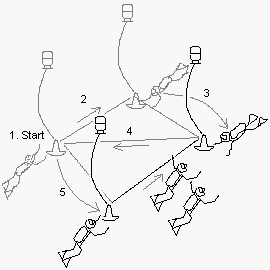4-Person Z Search
From TCEU
4-PERSON Z PATTERN Description The 4-person "Z" pattern is the same as the 2-person "Z" pattern except that it uses four divers:
* Two ANCHOR divers, one at each anchor.
They move the anchors down the sides of the pattern.
* A search team consisting of a SWEEP diver and a POINT diver.
* The SWEEP diver swims back and forth on the search line and
searches the area immediately around the line.
* The POINT diver stays in contact with the SWEEP and searches
the area ahead of the line.
The 4-person "Z" pattern uses two search buoys with a search line connected between their anchors. Start with the search line marking one end of the search area. The search team starts at one anchor and searches along the line. When they reach the other anchor, the anchor diver holds the search line taut and moves the anchor a few feet in the direction the pattern is moving. The search team then swims back along the line to the first anchor. The anchor diver there moves the anchor in the same direction as the other anchor moved. Then the search team repeats the process. This pattern moves the two anchors along the sides of the search area and sweeps the search line between them.

- JOB DESCRIPTIONS
SWEEP:
1. In charge of the team and recovery. 2. Searches along the search line.
POINT:
1. Stays in contact with the Sweep and searches ahead of the search line.
2. Responsible for all search activity.
The POINT works in undisturbed water ahead of the search line.
ANCHORS:
1. Stays at one anchor. 2. Moves his or her anchor along the side of the pattern, holding the line taut, when the search team reaches the anchor.
Finding and Recovering the Search Target: The SWEEP gives the 4-Pull "Found the Target" signal in both directions when the search team finds the target. The ANCHOR divers move in to the search team to assist with the recovery if needed. Starting the 4-Person Z Pattern This is a little easier than starting the 2-person Z but it still takes practice.
1. Connect the search line between the two anchors at the surface. 2. ON THE SURFACE, the search team splits up between the buoys. The SWEEP helps the ANCHOR diver at one buoy, and the POINT helps the ANCHOR at the other buoy. 3. Before lowering the anchors, position the starting buoy where you want one corner of the planned search area. Position the other buoy at the right heading along one end of the search area, but do not pull the search line taut at the surface. 4. Before lowering the anchors, both ANCHOR divers should set their compass markers for the heading between the two buoys at the surface. 5. Lower both buoys' anchors slowly, at the same time, with the search line connected between them. You left some slack between the anchors, so they should not drag each other out of position. 6. Both the SWEEP and POINT diver go to the second buoy. 7. The ANCHOR on the starting buoy descends from the starting buoy. 8. The other ANCHOR and the SEARCH TEAM descend from the second buoy. 9. The ANCHOR diver from the second buoy repositions his or her anchor so the search line is taut and in the right compass heading.
Tactics
1. Be sure all four divers agree on which direction the pattern will move before they leave the surface.
2. The 4-person Z works best if both anchor divers are about the same size so they will move their anchors the same distance.
3. The SWEEP should watch how the two anchors move. If the ANCHOR divers do not move their anchors the same distance, direct one of the ANCHOR divers to change the distance.
(We are looking at ways for the ANCHOR divers to mark the distance and direction to move while they wait for the search team to return.)
4. The 4-person Z bears off at a slight angle away from the anchor that moves first, just like the 2-person Z. Counteract that by making the first anchor move about half of the visibility distance.
5. The SEARCH TEAM should swim completely past the anchor line and turn around behind the ANCHOR diver while he or she moves the anchor. That keeps them from getting fouled in the anchor line in poor visibility.